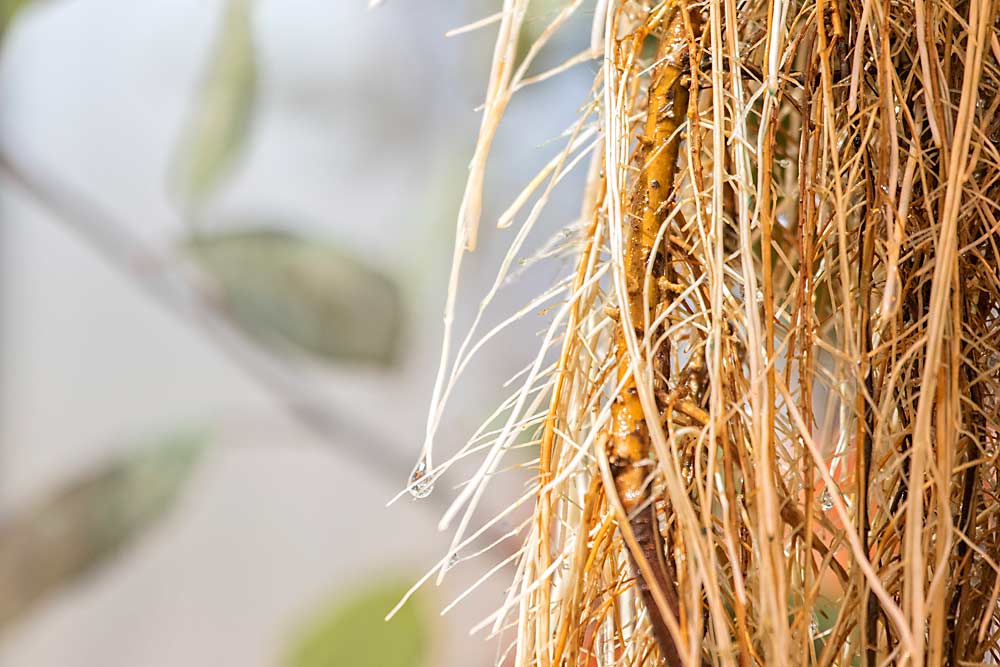
Root growth on Geneva rootstocks are shown at Cornell University’s Geneva, New York, greenhouses in July 2016. (TJ Mullinax/Good Fruit Grower)
Many apple growers are tapping into the new genetics of Geneva rootstocks to thwart disease and boost efficiencies. But not all New York growers — and that has researchers from Cornell University, where the roots were bred, making a renewed pitch to growers in their backyard and beyond.
During the International Fruit Tree Association annual meeting in Rochester, New York, in February, researchers focused one session on the importance of rootstock choice, which affects everything from disease control and crop load to nutrient uptake and disorders such as bitter pit.
Most of the presentations focused on roots from the Geneva line, designed by Cornell breeders to usher in a new era of high-density apple farming. Geneva roots are prized for their ability to thrive in thin soils, resist fire blight, keep certain pests at bay and grow quickly into the two-dimensional planar canopy systems that future mechanization will require. Growers all over the United States, including many in New York, are adopting them with new plantings.
However, many New York growers still commonly use Budagovsky 9 and Malling 9 rootstocks.
Growers are doing very well with Bud.9, but they could be doing even better — and making even more money — if they switched, said Cornell horticulturist Terence Robinson.
“You should probably never plant another orchard on M.9 or B.9,” he said. “That’s the message today.”
Geneva rootstocks can open up a dizzying array of options for growers shooting for certain densities, he said. (His presentation noted that 1,300 trees per acre is most profitable.) Robinson called some of the newer Cornell roots, such as Geneva 11, 41, 213, 935 and 969, “thoroughbreds” amid mules.
The popularity of the roots is exploding across the United States. In the years following their release, growers purchased between 1 million and 2 million per year, according to Cornell, Robinson said. Last year, they bought 8 million. Of those, 4 million were G.41 and 2.5 million were G.935.
The problem is, sometimes they’re hard to get, but Robinson believes tissue culture labs and work at the Clean Plant Center Northwest in Prosser, Washington, will help nurseries catch up. He counts 21 nurseries in the United States licensed to sell Geneva roots. Four of them have tissue culture labs, and that speeds up the propagation process. When compared to potential profitability gains, any extra cost for Geneva roots is “peanuts,” he said.
Many Geneva roots are headed to Washington state, where they make more sense due to high temperatures, the arid climate and sandier soils, said Rod Farrow, who just wrapped up his term as IFTA president. New York growers have richer, glacially deposited soils with more horsepower.
Near Rochester, Bud.9 fosters good fruit size, fills space, manages easily, resists fire blight and generally leads to excellent profits, especially when combined with irrigation, which more New York growers are installing these days, Farrow said. G.41 is probably more resistant to fire blight than Bud.9, he admitted, but not enough to warrant wholesale conversion.
One caveat, he cautioned, is that growers have better luck with Bud.9 if they plant at least 2,000 trees per acre. Some trials comparing rootstock performance use data from blocks planted at only 1,300 trees per acre, he said.
The popularity of Bud.9 in western New York started 15 years ago, before the Geneva days. Once growers established their canopy architectures with Bud.9, they preferred to continue with the same system. Changing rootstocks might require changing growing techniques, Farrow said.
Still, Farrow is open to change. In fact, he has plans to run some of his own Geneva trials in the coming years.
That’s what Gennaro Fazio, the U.S. Department of Agriculture breeder behind the rootstocks, recommends. He understands business decisions but advises growers to at least run trials before making up their minds. Many of those who have run trials on their farms are now trying to switch.
“You don’t know how many apples you are leaving on the table until you see a comparison,” Fazio said. •
—by Ross Courtney
Related: Deciphering designer rootstocks






Leave A Comment